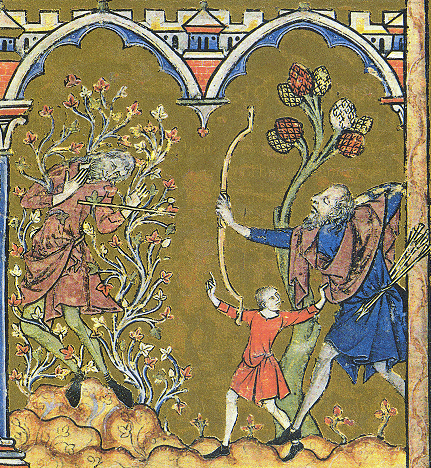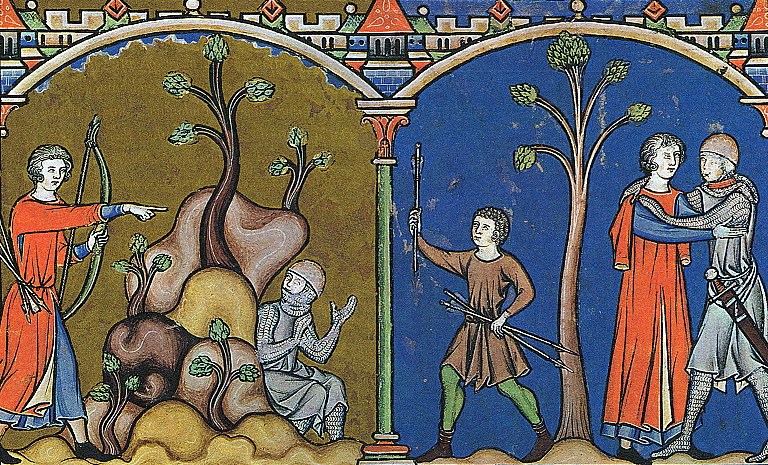
| myArmoury.com is now completely member-supported. Please contribute to our efforts with a donation. Your donations will go towards updating our site, modernizing it, and keeping it viable long-term.
Last 10 Donors: Anonymous, Daniel Sullivan, Chad Arnow, Jonathan Dean, M. Oroszlany, Sam Arwas, Barry C. Hutchins, Dan Kary, Oskar Gessler, Dave Tonge (View All Donors) |
| Author |
Message |
Elling Polden

|
 Posted: Mon 04 Jun, 2007 5:09 am Post subject: "Lobed" bows? Posted: Mon 04 Jun, 2007 5:09 am Post subject: "Lobed" bows? |
 |
|
Hi
I'm looking for pictures/sources on the lobed bows found in some manuscripts, like for the ones found in the


While not truly "recurves" these bow have "lobes", similar to those founds on recurves. I can remember seeing similar pictures, but I'm having difficulties with remembering where...
"this [fight] looks curious, almost like a game. See, they are looking around them before they fall, to find a dry spot to fall on, or they are falling on their shields. Can you see blood on their cloths and weapons? No. This must be trickery."
-Reidar Sendeman, from King Sverre's Saga, 1201
|
|
    |
 |
Stefan Toivonen

|
 Posted: Tue 05 Jun, 2007 1:24 am Post subject: Posted: Tue 05 Jun, 2007 1:24 am Post subject: |
 |
|
Didn't really find any picture of similar "lobed" bows, but this site might have some pictures that might interest you.
http://www.obbit.se/nt/recurve/index.html
|
|
  |
 |
|
Curt Cummins
Location: Portland, OR Joined: 03 May 2007
Posts: 63
|
 Posted: Tue 05 Jun, 2007 8:26 pm Post subject: Posted: Tue 05 Jun, 2007 8:26 pm Post subject: |
 |
|
The lobes you see in the pictures are the siyahs. These bows are "static" recurves - the siyahs remain rigid and do not bend or uncurl as the ends on more modern "working" recurves. Note how the string is touching the siyahs after the archer has loosed the arrow. There are lines draws on the back of the bow in the first picture that seem to suggest a composite or at least a backed bow.
If the artist accurately depicted the bow, and medieval artists were not always the greatest for accurate detail and perspective, then the lobes are probably curves on the tips to prevent the string from slipping off the ends if the bow is overdrawn.
I use the same technique on wood laminate reflex/deflex bows that I make and back with silk or bamboo. Unlike the typical European self bow - example English yew longbow -which are made of single piece of wood. composite bows can be overdrawn without breaking.
Who are these pictures of and where, geographically , were they.
Ye braggarts and awe be a'skeered and awa, frae Brandoch Daha
|
|
  |
 |
|
Lafayette C Curtis
|
 Posted: Tue 05 Jun, 2007 9:04 pm Post subject: Posted: Tue 05 Jun, 2007 9:04 pm Post subject: |
 |
|
I believe they're usually called ears instead of "lobes." You're referring to the small recurved/kinked part at the end, right?
And the sight of recurved bows in Europe isn't really that odd, not if you've looked at Carolingian art. Not to mention that English longbows--the archetypical European "simple" bow--sometimes has a recurve towards the end as well, especially if we count the horn string nocks attached to the ends of the staves.
|
|
  |
 |
Jared Smith

|
|
  |
 |
|
Curt Cummins
Location: Portland, OR Joined: 03 May 2007
Posts: 63
|
 Posted: Wed 06 Jun, 2007 4:22 am Post subject: Posted: Wed 06 Jun, 2007 4:22 am Post subject: |
 |
|
Look at the knots on the second bow - these look like traditional Chinese or Mongol knots for the string loops. European
bows normally used a braided string loop ala Flemish twist with double loops or a loop on the upper limb and a bowyers knot on the lower.
Chinese and Mongol archers used an endless loop string often tied in very elaborate knots. The loops were longer than on a European bow to allow the siyah to work.
Some recurve bows, both modern and ancient, have straight limbs with only the tips curving forward like the first picture. This style of bow was not unknown to the Europeans and self bows can be recurved by using steam or direct heat to bend the tips.
I misspoke in my first post, it is the second picture that looks more like a composite bow with a set back handle. This would be the general style used by the Hungarians, Poles, Tatars, Turks, Chinese etc. Each culture had their own variations on the basic design - a short bow with rigid static siyahs - sinew backing - horn belly.
If the pictures are from an eastern European source then the bows would be typical, if they are from a western European source then they would definitely be more interesting.
Ye braggarts and awe be a'skeered and awa, frae Brandoch Daha
|
|
  |
 |
Elling Polden

|
 Posted: Wed 06 Jun, 2007 4:55 am Post subject: Posted: Wed 06 Jun, 2007 4:55 am Post subject: |
 |
|
The pictures are from the maciowski bible, made in France around 1250.
http://www.medievaltymes.com/courtyard/maciejowski_bible.htm
The reason I'm asking is that an acquaintance of mine is going to write a master paper on the laminate bow fragments that have been found in Bergen, Norway.
There are at least strong indications that these are two-wood laminate bows with "ears"
These apparently where made with a backing of wood rather than horn. A 13th century manuscript mentions horn bows as well, so they would also be present in Norway in that period.
"this [fight] looks curious, almost like a game. See, they are looking around them before they fall, to find a dry spot to fall on, or they are falling on their shields. Can you see blood on their cloths and weapons? No. This must be trickery."
-Reidar Sendeman, from King Sverre's Saga, 1201
|
|
    |
 |
Stefan Toivonen

|
|
  |
 |
|
|
You cannot post new topics in this forum
You cannot reply to topics in this forum
You cannot edit your posts in this forum
You cannot delete your posts in this forum
You cannot vote in polls in this forum
You cannot attach files in this forum
You can download files in this forum
|
All contents © Copyright 2003-2024 myArmoury.com — All rights reserved
Discussion forums powered by phpBB © The phpBB Group
Switch to the Basic Low-bandwidth Version of the forum
|

